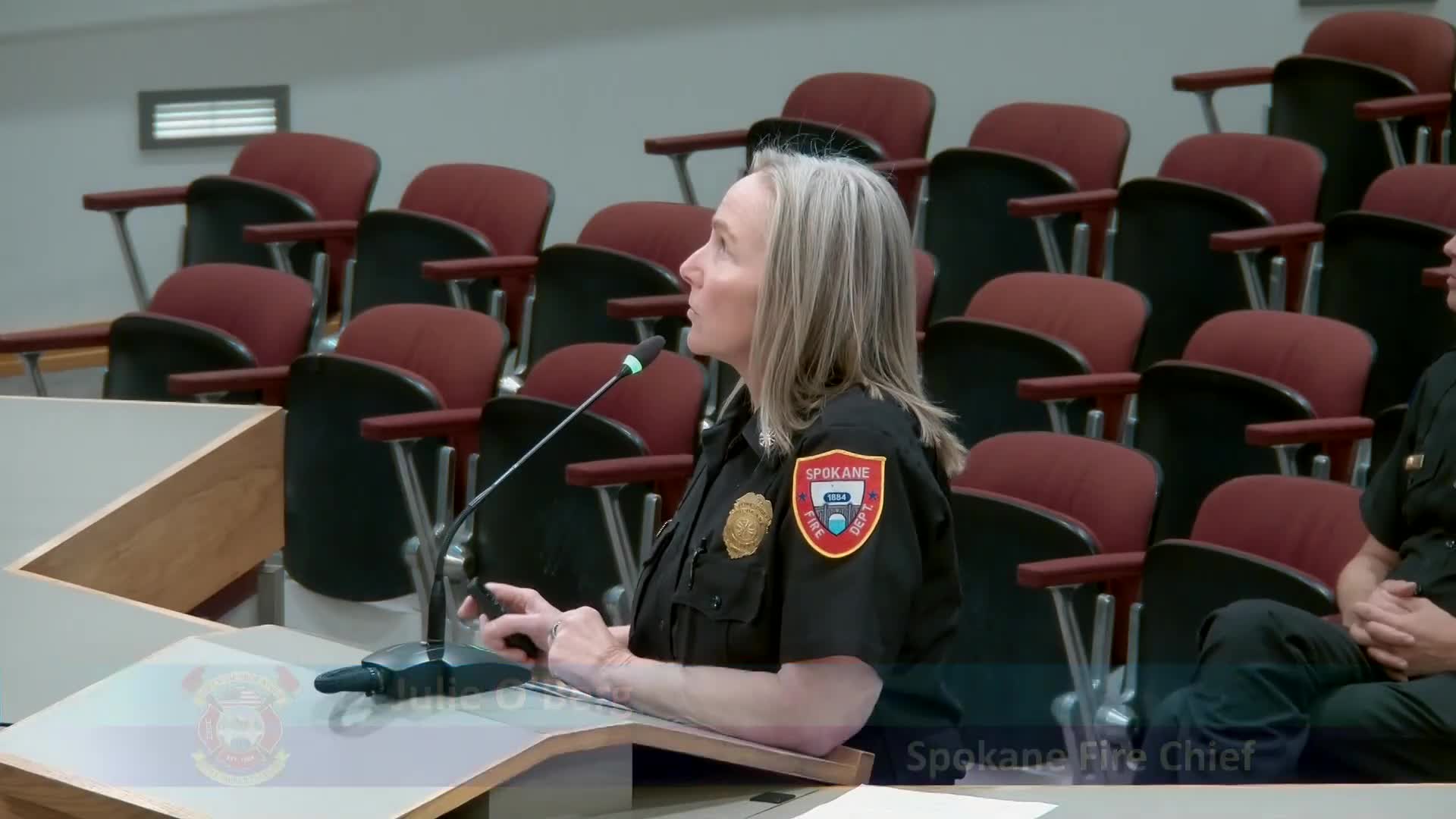Fire chief details staffing, overtime and mutual aid; city to allocate SHREK reimbursement to recruit academy expenses
October 06, 2025 | Spokane, Spokane County, Washington
This article was created by AI summarizing key points discussed. AI makes mistakes, so for full details and context, please refer to the video of the full meeting. Please report any errors so we can fix them. Report an error »

Fire Chief Dave Oberg and Battalion Chief Britney Forbes updated the Spokane City Public Safety Committee on Oct. 6 about department staffing, overtime and mutual/automatic aid, and Battalion Chief Forbes presented response and overdose metrics.
Oberg said the department had one retirement in September and expected additional retirements by year‑end, and that the current recruit academy had 18 recruits with two resignations since it began. He told the committee that overtime spending through the most recent pay period was about 17% higher than the same period last year and that total hours were about 23% higher.
“We did have 1 retirement in September and expect, 3 more by the end of the year,” Oberg said. He also noted the department plans a 2026 recruit academy to maintain staffing levels.
Battalion Chief Forbes presented response metrics showing that about 80%–82% of calls were medical and the remainder fire and other calls; structure fires in the city were down year‑to‑date while brush and outside fires followed seasonal patterns. Forbes walked the committee through mutual and automatic aid volumes, noting that the city both gives and receives aid from neighboring districts and that average time committed per call was similar across partner agencies.
Forbes and Chief Oberg also reviewed overdose dispatches for the month in which the department recorded 62 local Narcan administrations, 66 transports to emergency departments and one on‑scene death in August (as the slide deck summarized local EMS data). Forbes noted the difference between dispatch impressions and later determinations of overdose, and said staff were working on more accurate location coding for incidents labeled as “street.”
Budget item: Matt Boston presented a Special Budget Ordinance (SBO) allocating funds the city received under the SHREK reimbursements to cover back payments of expenses and the second 2025 recruit class. Boston said the SBO may be amended as additional payments arrive but is intended to allocate 2022–2024 attributable expenses and revenue for recruit costs and communications systems.
Ending: Chief Oberg offered brief closing remarks and thanked department staff; the committee acknowledged the workforce pressures and asked for further follow‑up materials on mutual aid hours and recruit‑academy timelines.
Oberg said the department had one retirement in September and expected additional retirements by year‑end, and that the current recruit academy had 18 recruits with two resignations since it began. He told the committee that overtime spending through the most recent pay period was about 17% higher than the same period last year and that total hours were about 23% higher.
“We did have 1 retirement in September and expect, 3 more by the end of the year,” Oberg said. He also noted the department plans a 2026 recruit academy to maintain staffing levels.
Battalion Chief Forbes presented response metrics showing that about 80%–82% of calls were medical and the remainder fire and other calls; structure fires in the city were down year‑to‑date while brush and outside fires followed seasonal patterns. Forbes walked the committee through mutual and automatic aid volumes, noting that the city both gives and receives aid from neighboring districts and that average time committed per call was similar across partner agencies.
Forbes and Chief Oberg also reviewed overdose dispatches for the month in which the department recorded 62 local Narcan administrations, 66 transports to emergency departments and one on‑scene death in August (as the slide deck summarized local EMS data). Forbes noted the difference between dispatch impressions and later determinations of overdose, and said staff were working on more accurate location coding for incidents labeled as “street.”
Budget item: Matt Boston presented a Special Budget Ordinance (SBO) allocating funds the city received under the SHREK reimbursements to cover back payments of expenses and the second 2025 recruit class. Boston said the SBO may be amended as additional payments arrive but is intended to allocate 2022–2024 attributable expenses and revenue for recruit costs and communications systems.
Ending: Chief Oberg offered brief closing remarks and thanked department staff; the committee acknowledged the workforce pressures and asked for further follow‑up materials on mutual aid hours and recruit‑academy timelines.
View full meeting
This article is based on a recent meeting—watch the full video and explore the complete transcript for deeper insights into the discussion.
View full meeting
